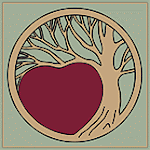To celebrate Heartwood Art carvings being featured in upcoming issue of Woodcarving Illustrated the "Follow My Carving" series was created to give you a an insider’s view on how the art is made.

Now that the circle around the tree is finished, it’s time to start on the leaves that adorn the corners. The same technique used on the circle outline works well here too. Since the lines can be a little tricky to see, I go over them lightly with a pencil first. Then I make a shallow incision with a carving knife all the way around and then another pass to deepen the cut. Next, I use a veiner tool (micro V gouge), to deepen and widen the cut slightly. This is the rough cut.
Since I need the lines to be more deep than wide, I use a rotary tool with a very narrow, pointed bit to deepen the lines smoothly. Running it at it’s slowest speed and holding it at a very shallow angle seems to work best for me.
After I deepen the lines a bit, I use an orbital sander with a triangular shaped face to lightly sand the entire surface outside the circle around the tree. Using this type of sander gives me good control and I can stay with the grain and get right up to the edge of the circle.

Once the sanding is finished, I go back over the leaf lines with the rotary tool to further deepen the lines and to clean up any edges. The final leaf looks like the picture to the right. It’s important to keep in mind that once a section of wood has been sanded, it’s not a good idea to go back over it with a carving gouge. Sandpaper debris and the finely honed edges of metal gouges don’t get along too well.
The leaf pattern is very versatile and can be slightly modified so that it can be scrolled, chip carved, or burned into the wood.
After all four leaves are finished, I go over the entire carving, front and back, to ensure every edge is clean with no burrs, loose chips or fuzzy edges. This is especially important in areas where branches meet.
The last step in the carving process is the bark, and that will be in the next installment.
To see more carvings, please visit the
Heartwood Art site.


















